 W
WUSS Albatross (1858) was a screw steamer rigged as a three-masted schooner acquired by the Union Navy during the beginning of the American Civil War. She was outfitted as a gunboat with heavy guns and used in the Union blockade of the waterways of the Confederate States of America.
 W
WThe first USS Alligator was a schooner in the United States Navy, built in 1809 as Gunboat No. 166 and renamed Alligator during the War of 1812. Upon completion she was placed in ordinary at Wilmington, North Carolina. She was commissioned sometime in mid-1809, under Master Commandant Joseph Tarbell.
 W
WThe third USS Alligator was a schooner in the United States Navy.
 W
WUSS Anemone IV (SP-1290) was a United States Navy patrol vessel in service from 1917 to 1919.
 W
WUSS Arabia (ID-3434) was a United States Navy patrol vessel in commission during 1918.
 W
WThe schooner Bowdoin was designed by William H. Hand, Jr., and built in 1921, in East Boothbay, Maine, at the Hodgdon Brothers Shipyard now known as Hodgdon Yachts. She is the only American schooner built specifically for Arctic exploration, and was designed under the direction of explorer Donald B. MacMillan. She has made 29 trips above the Arctic Circle in her life, three since she was acquired by the Maine Maritime Academy in 1988. She is currently owned by the Maine Maritime Academy, located in Castine, Maine, and is used for their sail training curriculum. She is named for Bowdoin College.
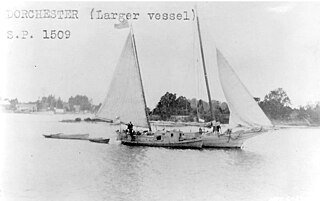 W
WThe Brown Smith Jones was a patrol boat of the Maryland State Fishery Police which also served in the United States Navy as a patrol vessel from 1917 to 1918.
 W
WUSS C. P. Williams (1861) was a mortar schooner acquired by the Union Navy during the American Civil War. She was used for various purposes, but, especially for bombardment because of her large 13 in (330 mm) mortar that could fire up and over tall riverbanks.
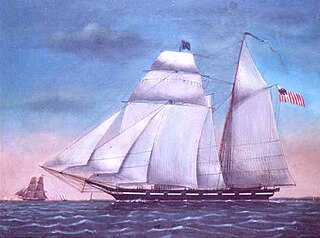 W
WThe United States Revenue Cutter Dexter was one of 13 cutters of the Morris-Taney Class to be launched. Named after Secretaries of the Treasury and Presidents of the United States, these cutters were the backbone of the Service for more than a decade. Samuel Humphreys designed these cutters for roles as diverse as fighting pirates, privateers, combating smugglers and operating with naval forces. He designed the vessels on a naval schooner concept. They had Baltimore Clipper lines. The vessels built by Webb and Allen, designed by Isaac Webb, resembled Humphreys' but had one less port.
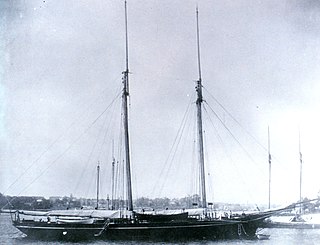 W
WUSC&GS Eagre was a survey ship of the U.S. Coast and Geodetic Survey, originally the yacht Mohawk, which later served in the United States Navy as USS Eagre.
 W
WUSS Echo (IX-95), an unclassified miscellaneous vessel, was the only ship of the United States Navy to be named for the nymph Echo. A sailing scow, she was used as a supply ship in the South Pacific from 1942 to 1944.
 W
WUSS Eclipse (SP-417) was a United States Navy patrol vessel in commission from 1917 to 1919.
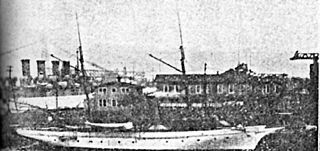 W
WUSS Elfrida, later USS Elfrida (SP-988), was a United States Navy patrol vessel in commission from 1898 to 1918. She served in the Spanish–American War and World War I.
 W
WThe third US ship to be named Enterprise was a schooner, built by Henry Spencer at Baltimore, Maryland, in 1799. Her first commander thought that she was too lightly built and that her quarters, in particular, should be bulletproofed. Enterprise was overhauled and rebuilt several times, effectively changing from a twelve-gun schooner to a fourteen-gun topsail schooner and eventually to a brig. Enterprise saw action in the Caribbean, the Mediterranean, and the Caribbean again, capturing numerous prizes. She wrecked in July 1823.
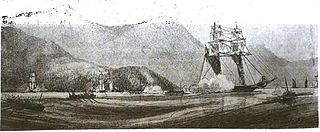 W
WUSS Experiment was a schooner in the United States Navy during the Quasi-War with France.
 W
WUSS Flying Fish (1838), a schooner, was formerly the New York City pilot boat Independence. Purchased by the United States Navy at New York City on 3 August 1838 and upon joining her squadron in Hampton Roads 12 August 1838 was placed under command of Passed Midshipman S. R. Knox.
 W
WThe United States Revenue Cutter Gallatin was one of 13 cutters of the Morris-Taney Class to be launched. Named after Secretaries of the Treasury and Presidents of the United States, these cutters were the backbone of the Revenue Marine Service for more than a decade. Samuel Humphreys designed these cutters for roles as diverse as fighting pirates, privateers, combating smugglers and operating with naval forces. He designed the vessels on a naval schooner concept. They had Baltimore Clipper lines. The vessels built by Webb and Allen, designed by Isaac Webb, resembled Humphreys' but had one less port.
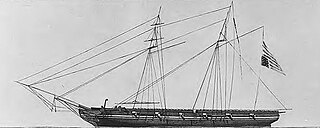 W
WUSS Grampus was a schooner in the United States Navy. She was the first U.S. Navy ship to be named for the Grampus griseus, also known as Risso's dolphin.
 W
W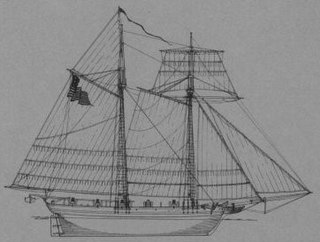 W
WThe first USS Hamilton was a United States Navy schooner which served on Lake Ontario from 1812 to 1813 during the War of 1812.
 W
WThe schooner Hannah was the first armed American naval vessel of the American Revolution and is claimed to be the founding vessel of the United States Navy. She was a fishing schooner owned by John Glover of Marblehead, Massachusetts and was named for his daughter, Hannah Glover. The crew was drawn largely from the town of Marblehead, with much of the ships ammunition being stored in Glover's warehouse now located at Glover's Square in Marblehead before being relocated to Beverly, Massachusetts.
 W
WUSS Helvetia (SP-3096) was a United States Navy patrol vessel in commission from 1918 to 1919.
 W
WThe famed Hodgdon Bros. in East Boothbay, Maine built Schooner Hindu in 1925. William H. Hand Jr., a renowned yacht designer, drew the plans for James W. Hall of New York City. The vessel's original name was the "Princess Pat," which is a sailor's song of Princess Patricia's Canadian Light Infantry Unit, currently stationed in Edmonton, Alberta. The schooner is a 79-foot half-scale model of a 19th-century Grand Banks fishing vessel.
 W
WUSS J. B. Walker was an old schooner hulk acquired by the U.S. Navy during World War I. Because of her age, condition and relatively large cargo capacity, she was used as a collier, carrying coal where needed. She was not self-propelled, and required to be towed from one port to another. Post-war, J. B. Walker was sold.
 W
WThe United States Revenue Cutter Jackson was one of 13 cutters of the Morris-Taney Class to be launched. Named after Secretaries of the Treasury and Presidents of the United States, these cutters were the backbone of the Revenue Cutter Service for more than a decade. Samuel Humphreys designed these cutters for roles as diverse as fighting pirates, privateers, combating smugglers and operating with naval forces. He designed the vessels on a naval schooner concept. They had Baltimore Clipper lines. The vessels built by Webb and Allen, designed by Isaac Webb, resembled Humphreys' but had one less port.
 W
WJulia Hamilton was a Maryland State Oyster Police Force schooner, part of the force established to enforce state conservation laws designed to protect Maryland's oyster resources when out of state, often New England, dredgers began destroying reefs in the Chesapeake Bay. Later local opposition to licenses turned to open "warfare" in the "oyster wars" when a fleet of state vessels fought "oyster pirates" in armed conflicts.
 W
WUSS Lanikai, was a schooner-rigged diesel powered yacht commissioned into the United States Navy during both World War I and World War II, before being transferred to the Royal Australian Navy.
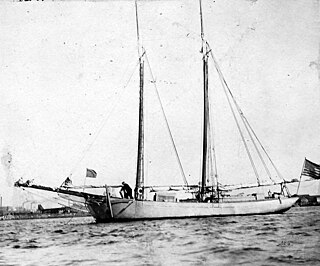 W
WUSS Laura Reed (SP-2009), also listed as ID-2009, was a United States Navy patrol vessel in commission from 1917 to 1919.
 W
WLibertad, meaning "liberty" in Spanish, was a merchant schooner built on the west coast of Mexico for service between Mexico and the Baja California peninsula and along the coast of Mexico. During the Mexican–American War, she was captured at Loreto, Mexico, along with the schooner Fortuna on 1 October 1846 by the United States Navy sloop-of-war USS Cyane under the command of Commander Samuel Francis Du Pont.
 W
WUSS Liberty III (SP-1229), sometimes written Liberty # 3 and also referred to during her naval career as Liberty and as #3 Pilot Boat, was a United States Navy patrol vessel in commission from 1917 to 1919.
 W
WHMS Little Belt was the mercantile sloop Friends Good Will, launched in 1811, which the British captured shortly after the start of the War of 1812. The British took her into service as Little Belt, armed her with three guns, and incorporated her into the Royal Navy's Lake Erie fleet. The American schooner Scorpion captured her during the Battle of Lake Erie and the Americans took her into service under her existing name. A storm drove her ashore in October 1813 and a British expeditionary force burnt her in December 1813.
 W
WUSS Louise No. 2 (SP-1230), sometimes written Louise # 2 and also referred to during her naval career as Louise and as Pilot Boat #2, was a United States Navy patrol vessel in commission from 1917 to 1919.
 W
WUSS Lynx, a 6-gun Baltimore Clipper-rigged schooner, was built for the United States Navy by James Owner of Georgetown, Washington, D.C., in 1814, intended for service in one of the two raiding squadrons being built as part of President James Madison's administration’s plan to establish a more effective Navy, one capable not only of breaking the British naval blockade, but also of raising havoc with the British merchant marine.
 W
WUSS Margaret (SP-531) was a schooner acquired by the U.S. Navy for temporary service during World War I.
 W
WUSS Metha Nelson (IX‑74) was a wooden‑hulled sailing schooner of the United States Navy during World War II.
 W
WThe first USS Mosquito was believed to have been purchased at Philadelphia late in 1775 for the new Continental Navy. She patrolled the Delaware River until destroyed during the British conquest of Philadelphia led by the Howe brothers and completed by them in October 1777. DANFS has identified this ship as a sloop, yet records from the period which are believed to refer to the ship have consistently identified her as being a schooner. These records also provide a bit more detail of her fate, indicating she was burned after capture in July 1777 during Royal Navy operations along the Delaware River.
 W
WNautilus was a schooner launched in 1799. The United States Navy purchased her in May 1803 and commissioned her USS Nautilus; she thus became the first ship to bear that name. She served in the First Barbary War. She was altered to a brigantine. The British captured Nautilus early in the War of 1812 and renamed her HMS Emulous. After her service with the Royal Navy, the Admiralty sold her in 1817.
 W
WUSS Nellie Jackson (SP-1459) was a United States Navy patrol vessel in commission from 1917 to 1918.
 W
WUSS Para (1861) was a schooner acquired by the Union Navy during the American Civil War. She was used by the Navy to patrol navigable waterways of the Confederacy to prevent the South from trading with other countries.
 W
WThe Puritan is a 126-foot gaff rigged schooner designed by naval architect John Alden and built-in 1930. Originally commissioned by Edward W. Brown in 1929, it was later used as a patrol schooner by the United States Navy during World War II. The Puritan has been used mainly as a charter vessel and undergone numerous restorations. It is currently operated by The Classic Yacht Experience and used as a charter in the Mediterranean Sea.
USS Racer (1861) was a schooner acquired by the Union Navy during the American Civil War. She was used for various purposes, but, especially for bombardment because of her large 13-inch mortar that could fire up and over tall riverbanks.
 W
WUSS Robert H. McCurdy was a United States Navy patrol vessel in commission from 1918 to 1919.
 W
WUSS Sea Gull was a schooner in the service of the United States Navy. The Sea Gull was one of six ships that sailed in the US Exploring Expedition in 1838 to survey the coast of the then-unknown continent of Antarctica and the Pacific Islands. The specimens collected on the voyage would later form the backbone of the Smithsonian Institution.
 W
WThe fourth USS Seneca (SP-1240) was a United States Navy barge in commission from 1917 to 1919.
 W
WThe first USS Shark was a schooner in the United States Navy. Built in the Washington Navy Yard to the designs of Henry Steers, Shark was launched on 17 May 1821. On 11 May 1821, Matthew C. Perry was ordered to take command of Shark, and the ship was ready to receive her crew on 2 June 1821.
 W
WUSS Anemone IV (SP-1290) was a United States Navy patrol vessel in service from 1917 to 1919.
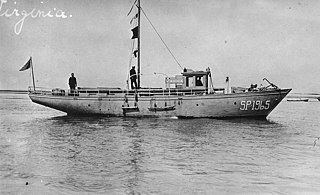 W
WUSS Virginia (SP-1965) was a two-masted, auxiliary schooner in the United States Navy.
 W
WUSS Virginia (SP-1965) was a two-masted, auxiliary schooner in the United States Navy.
 W
WUSS Vixen was a schooner in the United States Navy during the First Barbary War. Vixen was one of four vessels authorized by Congress on 28 February 1803. She was built at Baltimore, Maryland, in the spring of 1803; and launched on 25 June, Lieutenant John Smith in command.
 W
WThe first USS Wanderer was a high-speed schooner originally built for pleasure. It was used in 1858 to illegally import slaves from Africa. It was seized for service with the United States Navy during the American Civil War. In U.S. Navy service from 1861 to 1865, and under outright U.S. Navy ownership from 1863 to 1865, she was used by the Union Navy as a gunboat, as a tender, and as a hospital ship. She was decommissioned, put into merchant use, and lost off Cuba in 1871.
 W
WWashington (SP-1241) was a seagoing schooner barge that served in the United States Navy in 1917.
 W
WThe United States Revenue Cutter Washington was one of the 13 cutters of the Morris-Taney class. These cutters were the backbone of the United States Revenue Cutter Service for more than a decade. Samuel Humphreys designed these cutters for roles as diverse as fighting pirates, privateers, combating smugglers and operating with naval forces. He designed the vessels on a naval schooner concept. They had Baltimore Clipper lines. The vessels built by Webb and Allen, designed by Isaac Webb, resembled Humphreys' but had one less port.
 W
WThe Continental Ship Wasp was originally a merchant schooner named Scorpion, built at Baltimore, and purchased under authority from the Second Continental Congress dated 2 December 1775 by Col. Benjamin Harrison sometime between 2 and 18 December 1775, the first US naval ship to be given that name. She was outfitted in Baltimore from December 1775 to early 1776; and commissioned in December 1775 or January 1776, Capt. William Hallock in command.
 W
WUSS Wildcat was a two masted schooner of 48 tons and was part of a naval fleet, the West Indies Squadron, that sailed to the Caribbean to subdue the occurrence of pirate raids on merchant ships that had increased to almost 3,000 by the early 1820s. She was armed with three guns and had a crew of 31. Wildcat was commanded by Lieutenant Legare' who sailed her to Washington with a dispatch regarding the disposition of the squadron and other matters concerning the war against piracy in the Caribbean. On 28 October 1824 Wildcat was lost in a gale with all hands while sailing between Cuba and Thompson's Island, West Indies. Approximately 31 drowned.
 W
WThe United States Revenue Cutter Wolcott was one of 13 revenue cutters of the Morris-Taney Class to be launched. Named after Secretaries of the Treasury and Presidents of the United States, these cutters were the backbone of the United States Revenue-Marine for more than a decade. Samuel Humphreys designed these cutters for roles as diverse as fighting pirates, privateers, combating smugglers and operating with naval forces. He designed the vessels on a naval schooner concept. They had Baltimore Clipper lines. The vessels built by Webb and Allen, designed by Isaac Webb, resembled Humphreys' but had one less port.
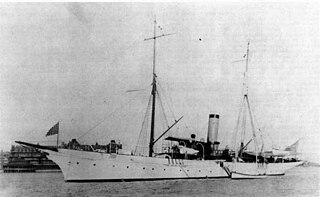 W
WUSS Yankton was a steel-hulled schooner built in 1893 at Leith, Scotland, by Ramage & Ferguson. She was acquired by the US Navy in May 1898; renamed Yankton; and commissioned on 16 May 1898 at Norfolk, Virginia, with Lt. Comdr. James D. Adams in command.